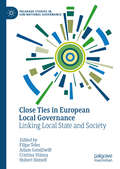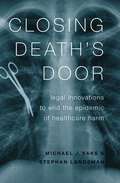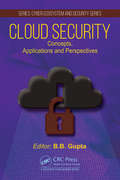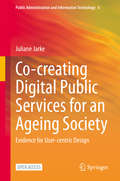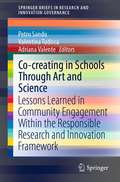- Table View
- List View
The Cloaking of Power: Montesquieu, Blackstone, and the Rise of Judicial Activism
by Paul O. CarreseHow did the US judiciary become so powerful—powerful enough that state and federal judges once vied to decide a presidential election? What does this prominence mean for the law, constitutionalism, and liberal democracy? In The Cloaking of Power, Paul O. Carrese provides a provocative analysis of the intellectual sources of today’s powerful judiciary, arguing that Montesquieu, in his Spirit of the Laws, first articulated a new conception of the separation of powers and strong but subtle courts. Montesquieu instructed statesmen to “cloak power” by placing judges at the center of politics, while concealing them behind juries and subtle reforms. Tracing this conception through Blackstone, Hamilton, and Tocqueville, Carrese shows how it led to the prominence of judges, courts, and lawyers in America today. But he places the blame for contemporary judicial activism squarely at the feet of Oliver Wendell Holmes Jr. and his jurisprudential revolution, which he believes to be the source of the now-prevalent view that judging is merely political. To address this crisis, Carrese argues for a rediscovery of an independent judiciary—one that blends prudence and natural law with common law and that observes the moderate jurisprudence of Montesquieu and Blackstone, balancing abstract principles with realistic views of human nature and institutions. He also advocates for a return to the complex constitutionalism of the American founders and Tocqueville and for judges who understand their responsibility to elevate citizens above individualism, instructing them in law and right.
The Close Relationship between Nietzsche's Two Most Important Books
by T. H. BrobjerThis book studies the close relationship between Thus Spoke Zarathustra and the unfinished four volume Revaluation of All Values that he worked on until shortly before his collapse. It is unlikely that he would have returned to and continued Thus Spoke Zarathustra, but he considered publishing the fourth part (which had not yet been published) as a bridge between Zarathustra and the unfinished Revaluation of All Values. More importantly, during his last years he worked hard on revaluing values, often in line with what he had written in Thus Spoke Zarathustra. This present study performs detailed analyses of Nietzsche’s texts and late notes to examine the direction of that unfinished work; it will function as a stimulus to further research on the direction, interpretation and consequences of Nietzsche’s late thought.
Close Ties in European Local Governance: Linking Local State and Society (Palgrave Studies in Sub-National Governance)
by Filipe Teles Adam Gendźwiłł Cristina Stănuș Hubert HeineltThis book develops and tests a typology of local state-society relations. To deliver such a comparative study on institutionalized relations between local government and societal actors at the municipal level in Europe, the book identifies and classifies country-specific patterns of these institutionalized governance networks. This work explores the diversity within these institutionalized networks, approaching it from a strong comparative perspective that is anchored on a new typology allowing a more robust analysis of the identifiable patterns. It is a study with appeal to scholars and students of local government, public administration and political science as well as to those pursuing this debate and implementing similar agendas as practitioners.
The Closers (Harry Bosch Series #11)
by Michael ConnellyAfter three years as a PI, Harry Bosch returns to the LAPD. The superb page-turning eleventh Bosch novel from the award-winning No. 1 bestselling author. Harry is back, assigned to the LAPD's Open-Unsolved Unit with his former cop ally and partner, Kizmin Rider. These detectives are the Closers. They are thrown into a politically sensitive and dangerous case when a white supremacist is connected to the 1988 murder of a mixed race girl. The police department has changed, but one thing hasn't - Harry's nemesis, Irving. The former Deputy Chief has been pushed from power and given a virtually meaningless new role. Full of vengeance, Irving calls Harry a 'retread'. He watches from the sidelines like an injured bear, hoping Harry will make a mistake . . .
Closing Death's Door: Legal Innovations to End the Epidemic of Healthcare Harm
by Stephan Landsman Michael J. SaksAfter heart disease and cancer, the third leading cause of death in the United States is iatrogenic injury (avoidable injury or infection caused by a healer). Research suggests that avoidable errors claim several hundred thousand lives every year. The principal economic counterforce to such errors, malpractice litigation, has never been a particularly effective deterrent for a host of reasons, with fewer than 3% of negligently injured patients (or their families) receiving any compensation from a doctor or hospital's insurer. Closing Death's Door brings the psychology of decision making together with the law to explore ways to improve patient safety and reduce iatrogenic injury, when neither the healthcare industry itself nor the legal system has made a substantial dent in the problem. Beginning with an unflinching introduction to the problem of patient safety, the authors go on to define iatrogenic injury and its scope, shedding light on the culture and structure of a healthcare industry that has failed to effectively address the problem-and indeed that has influenced legislation to weaken existing legal protections and impede the adoption of potentially promising reforms. Examining the weak points in existing systems with an eye to using law to more effectively bring about improvement, the authors conclude by offering a set of ideas intended to start a conversation that will lead to new legal policies that lower the risk of harm to patients. Closing Death's Door is brought to vivid life by the stories of individuals and groups that have played leading roles in the nation's struggle with iatrogenic injury, and is essential reading for medical and legal professionals, as well as lawmakers and laypeople with an interest in healthcare policy.
Closing Death's Door: Legal Innovations to End the Epidemic of Healthcare Harm
by Michael J. Saks Stephan LandsmanAfter heart disease and cancer, the third leading cause of death in the United States is iatrogenic injury (avoidable injury or infection caused by a healer). Research suggests that avoidable errors claim several hundred thousand lives every year. The principal economic counterforce to such errors, malpractice litigation, has never been a particularly effective deterrent for a host of reasons, with fewer than 3% of negligently injured patients (or their families) receiving any compensation from a doctor or hospital's insurer. Closing Death's Door brings the psychology of decision making together with the law to explore ways to improve patient safety and reduce iatrogenic injury, when neither the healthcare industry itself nor the legal system has made a substantial dent in the problem. Beginning with an unflinching introduction to the problem of patient safety, the authors go on to define iatrogenic injury and its scope, shedding light on the culture and structure of a healthcare industry that has failed to effectively address the problem-and indeed that has influenced legislation to weaken existing legal protections and impede the adoption of potentially promising reforms. Examining the weak points in existing systems with an eye to using law to more effectively bring about improvement, the authors conclude by offering a set of ideas intended to start a conversation that will lead to new legal policies that lower the risk of harm to patients. Closing Death's Door is brought to vivid life by the stories of individuals and groups that have played leading roles in the nation's struggle with iatrogenic injury, and is essential reading for medical and legal professionals, as well as lawmakers and laypeople with an interest in healthcare policy.
Closing the Courthouse Door: How Your Constitutional Rights Became Unenforceable
by Erwin ChemerinskyA leading legal scholar explores how the constitutional right to seek justice has been restricted by the Supreme Court The Supreme Court’s decisions on constitutional rights are well known and much talked about. But individuals who want to defend those rights need something else as well: access to courts that can rule on their complaints. And on matters of access, the Court’s record over the past generation has been almost uniformly hostile to the enforcement of individual citizens’ constitutional rights. The Court has restricted who has standing to sue, expanded the immunity of governments and government workers, limited the kinds of cases the federal courts can hear, and restricted the right of habeas corpus. Closing the Courthouse Door, by the distinguished legal scholar Erwin Chemerinsky, is the first book to show the effect of these decisions: taken together, they add up to a growing limitation on citizens’ ability to defend their rights under the Constitution. Using many stories of people whose rights have been trampled yet who had no legal recourse, Chemerinsky argues that enforcing the Constitution should be the federal courts’ primary purpose, and they should not be barred from considering any constitutional question.
Closing the Justice Gap for Adult and Child Sexual Assault: Rethinking the Adversarial Trial
by Anne CossinsThis book examines the justice gap and trial process for sexual assault against both adults and children in two jurisdictions: England and Wales and New South Wales, Australia. Drawing on decades of research, it investigates the reality of the policing and prosecution of sexual assault offences – often seen as one of the ‘hardest crimes to prosecute’ – across two similar jurisdictions. Despite the introduction of the many reform options detailed in the book, satisfactory outcomes for victims and the public are still difficult to obtain.Cossins takes a new approach by examining the nature and effects of adversarialism on vulnerable witnesses, jury decision-making and the structures of power within the trial process, to show how, and at what points, that process is weighted against complainants of sexual assault, in order to make evidence-based suggestions for reform. She argues that this justice gap is a result of a moralistic adversarial culture which fosters myths and misconceptions about rape and child sexual assault, thus requiring the prosecution to prove a complainant’s moral worthiness. She argues this culture can only be eliminated by a radical replacement of the adversarial system with a trauma-informed system. By reviewing the relevant psychological literature, this book documents the triggers for re-traumatisation within an adversarial trial, and discusses the reform measures that would be necessary to transform the sexual assault trial from one where the complainant’s moral worthiness is ‘on trial’ to a fully functioning trauma-informed system. It speaks to students and academics across subjects including law, criminology, gender studies and psychology, and practitioners in law and victim services, as well as policy-makers.
Cloud Computing Law
by Christopher MillardCloud computing continues to expand dramatically and the 'as a Service' model is now both mainstream and ubiquitous. Cloud now encompasses everything from the remote provision of essential computer processing and storage resources, through to delivery of complex business and government services, logistics, healthcare, education, and entertainment. The Covid-19 pandemic provided a striking demonstration of cloud computing's global scalability and resilience, as billions of workers and students switched in a matter of weeks to working and studying 'from home'. This book delivers an accessible analysis of the key legal and regulatory issues that surround cloud computing. Topics covered include contracts for cloud services, information ownership and licensing, privacy and data protection, standards and competition law, law enforcement access to data, and international tax models for cloud and other digital services. The book is organised in four parts. Part I explains what cloud computing is, why it matters, and what non-technical readers need to know about how it works. Part II includes a detailed review of standard contracts for 40 cloud services and highlights key legal and commercial issues that arise in negotiated transactions for cloud services. Ownership of, and access to, 'digital assets' are also explored. Part III focusses on the application of data protection and cybersecurity rules, including an in-depth assessment of the impact of the EU's General Data Protection Regulation (GDPR) on providers and users of cloud services. Finally, Part IV addresses governance issues relating to public sector use of cloud, access to cloud data by law enforcement authorities, competition rules and standards, and the disruption to global taxation models caused by the rapid shift to cloud services.
Cloud Computing Law
Cloud computing continues to expand dramatically and the 'as a Service' model is now both mainstream and ubiquitous. Cloud now encompasses everything from the remote provision of essential computer processing and storage resources, through to delivery of complex business and government services, logistics, healthcare, education, and entertainment. The Covid-19 pandemic provided a striking demonstration of cloud computing's global scalability and resilience, as billions of workers and students switched in a matter of weeks to working and studying 'from home'. This book delivers an accessible analysis of the key legal and regulatory issues that surround cloud computing. Topics covered include contracts for cloud services, information ownership and licensing, privacy and data protection, standards and competition law, law enforcement access to data, and international tax models for cloud and other digital services. The book is organised in four parts. Part I explains what cloud computing is, why it matters, and what non-technical readers need to know about how it works. Part II includes a detailed review of standard contracts for 40 cloud services and highlights key legal and commercial issues that arise in negotiated transactions for cloud services. Ownership of, and access to, 'digital assets' are also explored. Part III focusses on the application of data protection and cybersecurity rules, including an in-depth assessment of the impact of the EU's General Data Protection Regulation (GDPR) on providers and users of cloud services. Finally, Part IV addresses governance issues relating to public sector use of cloud, access to cloud data by law enforcement authorities, competition rules and standards, and the disruption to global taxation models caused by the rapid shift to cloud services.
The Cloud of Unknowing: The Classic of Medieval Mysticism
by Evelyn UnderhillAn exploration of the nature of reality, mysticism begins with the individual struggle toward a clear vision and culminates in a transformed consciousness. This marvelous guide to the contemplative life originated with the reflection of an unknown fourteenth-century priest who believed that a "cloud of unknowing" separates people from God. This cloud, he maintained, cannot be penetrated by intellect —only by love.The Cloud of Unknowing offers an approach to contemplative life that finds holiness at a level deeper than physical experience and beyond language or image. The author advises placing all thought and mental imagery behind a metaphorical "cloud of forgetting" while seeking to love the divine. Hidden from the infinite consciousness by a "cloud of unknowing," divine love can be reached through monologistic prayer — a single-word prayer, like a mantra, that assists in abandoning all extraneous thought. Seekers can thus attain an inner silence, where they may "be still and know the sacred."The author's spiritual gifts, combined with his humorous and straightforward approach, offer a view of divinity that never loses the common touch. Written in everyday language and edited by a popular authority on mysticism, this venerable work can be understood and appreciated by any reader.
Cloud Security: Concepts, Applications and Perspectives (Cyber Ecosystem and Security)
by Brij B. GuptaCloud computing is an indispensable part of the modern Information and Communication Technology (ICT) systems. Cloud computing services have proven to be of significant importance, and promote quickly deployable and scalable IT solutions with reduced infrastructure costs. However, utilization of cloud also raises concerns such as security, privacy, latency, and governance, that keep it from turning into the predominant option for critical frameworks. As such, there is an urgent need to identify these concerns and to address them.Cloud Security: Concepts, Applications and Perspectives is a comprehensive work with substantial technical details for introducing the state-of-the-art research and development on various approaches for security and privacy of cloud services; novel attacks on cloud services; cloud forensics; novel defenses for cloud service attacks; and cloud security analysis. It discusses the present techniques and methodologies, and provides a wide range of examples and illustrations to effectively show the concepts, applications, and perspectives of security in cloud computing. This highly informative book will prepare readers to exercise better protection by understanding the motivation of attackers and to deal with them to mitigate the situation. In addition, it covers future research directions in the domain. This book is suitable for professionals in the field, researchers, students who are want to carry out research in the field of computer and cloud security, faculty members across universities, and software developers engaged in software development in the field.
Cloud Security: Concepts, Applications and Perspectives (Cyber Ecosystem and Security)
by Brij B GuptaCloud computing is an indispensable part of the modern Information and Communication Technology (ICT) systems. Cloud computing services have proven to be of significant importance, and promote quickly deployable and scalable IT solutions with reduced infrastructure costs. However, utilization of cloud also raises concerns such as security, privacy, latency, and governance, that keep it from turning into the predominant option for critical frameworks. As such, there is an urgent need to identify these concerns and to address them.Cloud Security: Concepts, Applications and Perspectives is a comprehensive work with substantial technical details for introducing the state-of-the-art research and development on various approaches for security and privacy of cloud services; novel attacks on cloud services; cloud forensics; novel defenses for cloud service attacks; and cloud security analysis. It discusses the present techniques and methodologies, and provides a wide range of examples and illustrations to effectively show the concepts, applications, and perspectives of security in cloud computing. This highly informative book will prepare readers to exercise better protection by understanding the motivation of attackers and to deal with them to mitigate the situation. In addition, it covers future research directions in the domain. This book is suitable for professionals in the field, researchers, students who are want to carry out research in the field of computer and cloud security, faculty members across universities, and software developers engaged in software development in the field.
Cloud-Service-Zertifizierung: Ein Rahmenwerk und Kriterienkatalog zur Zertifizierung von Cloud-Services
by Sebastian Lins Stephan Schneider Ali SunyaevDieses Buch liefert ein Rahmenwerk zur Zertifizierung von Services in der Cloud. Herzstück dabei ist ein umfangreicher Kriterienkatalog zum Assessment von Cloud-Services, der im Forschungsprojekt „Value4Cloud“ , gefördert vom Bundesministerium für Wirtschaft und Technologie, entwickelt wurde. Cloud-Service-Anwender werden bei der Bewertung, dem Vergleich und der Auswahl von Services unterstützt. Das Buch eignet sich auch für Cloud-Service-Anbieter zum Self-Assessment und zur Verbesserung der eigenen Services.
Cloud-Service-Zertifizierung: Ein Rahmenwerk und Kriterienkatalog zur Zertifizierung von Cloud-Services
by Stephan Schneider Ali SunyaevDie Auslagerung von Services in die Cloud ist mit Risiken verbunden. Dieses Buch liefert ein Rahmenwerk zur Zertifizierung von Services in der Cloud. Herzstück dabei ist ein umfangreicher Kriterienkatalog zum Assessment von Cloud-Services. Dabei wendet sich das Buch an Cloud-Service-Anwender und unterstützt bei der Bewertung, dem Vergleich und der Auswahl von Angeboten. Gerade in kritischen Bereichen wie Sicherheit, Verfügbarkeit und Vertragsfragen unterstützt der Katalog bei der Definition von eigenen Anforderungen. Das Buch eignet sich jedoch auch für Cloud-Service-Anbieter, die es zum Self-Assessment und zur Verbesserung der eigenen Services nutzen können. Das Buch fasst eines der Ergebnisse des dreijährigen Forschungsprojekts „Value4Cloud“ zusammen, das im Rahmen des Technologieprogramms „Trusted Cloud“ vom Bundesministerium für Wirtschaft und Technologie gefördert wurde. Es liefert mit 219 Zertifizierungskriterien und einem Zertifizierungsrahmenwerk einen wichtigen Beitrag zum Assessment von Cloud-Services und der Verbesserung von Cloud-Service-Zertifizierungen.
CMR: Contracts for the International Carriage of Goods by Road (Lloyd's Shipping Law Library)
by Andrew Messent David GlassNow in its fourth edition, this hallmark text provides a comprehensive, article-by-article guide to the workings of the CMR Convention, as incorporated into English Law by the Carriage of Goods by Road Act 1965. This new edition is fully up to date with all major UK case law, plus major developments in the interpretation of the Convention in the case law of other Contracting States. Furthermore, the book includes expert guidance on the amendments introduced by the additional protocol concerning the electronic consignment note of 2008. The relationship between CMR and potentially conflicting legislation, in particular the Judgments Regulation of 2001 and the Judgments Regulation (recast) of 2012, are also usefully examined. Praised as well-written and extremely accessible, Messent and Glass offer a level of expert detail and referencing that cannot be found elsewhere. This work is an invaluable reference tool that can be used by the busy legal practitioner, and by other road haulage industry professionals, in any contracting state, to solve the issues that confront them in daily practice. It is also an indispensable guide for academics and students of the international carriage of goods by road.
CMR: Contracts for the International Carriage of Goods by Road (Lloyd's Shipping Law Library)
by Andrew Messent David GlassNow in its fourth edition, this hallmark text provides a comprehensive, article-by-article guide to the workings of the CMR Convention, as incorporated into English Law by the Carriage of Goods by Road Act 1965. This new edition is fully up to date with all major UK case law, plus major developments in the interpretation of the Convention in the case law of other Contracting States. Furthermore, the book includes expert guidance on the amendments introduced by the additional protocol concerning the electronic consignment note of 2008. The relationship between CMR and potentially conflicting legislation, in particular the Judgments Regulation of 2001 and the Judgments Regulation (recast) of 2012, are also usefully examined. Praised as well-written and extremely accessible, Messent and Glass offer a level of expert detail and referencing that cannot be found elsewhere. This work is an invaluable reference tool that can be used by the busy legal practitioner, and by other road haulage industry professionals, in any contracting state, to solve the issues that confront them in daily practice. It is also an indispensable guide for academics and students of the international carriage of goods by road.
Co-creating Digital Public Services for an Ageing Society: Evidence for User-centric Design (Public Administration and Information Technology #6)
by Juliane JarkeThis open access book attends to the co-creation of digital public services for ageing societies. Increasingly public services are provided in digital form; their uptake however remains well below expectations. In particular, amongst older adults the need for public services is high, while at the same time the uptake of digital services is lower than the population average. One of the reasons is that many digital public services (or e-services) do not respond well to the life worlds, use contexts and use practices of its target audiences. This book argues that when older adults are involved in the process of identifying, conceptualising, and designing digital public services, these services become more relevant and meaningful.The book describes and compares three co-creation projects that were conducted in two European cities, Bremen and Zaragoza, as part of a larger EU-funded innovation project. The first part of the book traces the origins of co-creation to three distinct domains, in which co-creation has become an equally important approach with different understandings of what it is and entails: (1) the co-production of public services, (2) the co-design of information systems and (3) the civic use of open data. The second part of the book analyses how decisions about a co-creation project’s governance structure, its scope of action, its choice of methods, its alignment with strategic policies and its embedding in existing public information infrastructures impact on the process and its results. The final part of the book identifies key challenges to co-creation and provides a more general assessment of what co-creation may achieve, where the most promising areas of application may be and where it probably does not match with the contingent requirements of digital public services. Contributing to current discourses on digital citizenship in ageing societies and user-centric design, this book is useful for researchers and practitioners interested in co-creation, public sector innovation, open government, ageing and digital technologies, citizen engagement and civic participation in socio-technical innovation.
Co-creating in Schools Through Art and Science: Lessons Learned in Community Engagement Within the Responsible Research and Innovation Framework (SpringerBriefs in Research and Innovation Governance)
by Petru Sandu Valentina Tudisca Adriana ValenteThis book represents an applied, up-to-date work on RRI developments and their potential positive impact on societies. The societal challenges of the 21st century require the ability to integrate the knowledge and expertise of different societal actors, using more innovative, efficient and open approaches. Educational methodologies are in perpetual development in their attempt to provide tentative answers to three ever-changing digital age challenges: the challenge of speed, the challenge of form/at and the challenge of persistency. The current book aims to address these issues by presenting relevant case studies in the field of art, science and giving value to territory that, by the means of projects and initiatives using RRI consistent methodologies, have succeeded in their attempt to: preserve and valorise cultural heritage by using digital storytelling or crowddreaming methodology, develop educational strategies grounded on RRI and Open Schooling principles, contribute to new ways of thinking in the school environment by using RRI and promote gender equality and stimulate critical reflections on women’s role in science by the means of storytelling and RRI concepts.
The Co-creative Meeting: Practicing Consensual Effectivity in Organizations (SpringerBriefs in Business)
by Christoph Mandl Markus Hauser Hanna Mandl“Co-creative meetings” foster invention and innovation, and therefore enable innovative developmental processes in an organizational and inter-organizational context, including strategy development, product development, human resource development, R&D, and trans-organizational projects. This book illustrates the difference between productive and innovative organizations and what that difference means for meetings taking place in such organizations, both from a conceptual and practical point of view. It provides managers, coaches, consultants and other professionals whose job it is to organize meetings with clear and action-oriented guidelines for the design of “co-creative meetings”, and also shows how to incorporate them through experiential learning.
Co-operative Compliance and the OECD’s International Compliance Assurance Programme
by Ronald Hein Ronald RussoProminent among initiatives addressing the urgent need for a common understanding between multinational enterprises (MNEs) and national tax authorities about risks and risk assessment is the International Compliance Assurance Programme (ICAP), which provides a channel for MNEs to engage in simultaneous discussions with multiple national tax administrations, thus enhancing the potential for advance tax assurance. To a certain extent, the ICAP represents the internationalization of Co-operative Compliance frameworks which were, until then, restricted within the borders of single jurisdictions. This book is the first to investigate Co-operative Compliance alongside with the ICAP, describing developments in twelve countries (Australia, Austria, Canada, Germany, Italy, Japan, the Netherlands, Norway, Poland, Spain, the United Kingdom, and the United States). Following a general introduction, two opening perspectives on the ICAP are presented, one from the OECD and one from a participating tax administration (the Netherlands), leading to the twelve country reports and a special chapter on transfer pricing, which is the main issue in international tax disputes. Specific elements reviewed include the following: criteria to enter the programme; the range of taxes covered by the programme; real-time consultation procedures; appeal procedures within the programme; the possibility to ‘agree to disagree’ and to continue Co-operative Compliance even in cases of litigation; risk management strategies within tax authorities; corporate administrative compliance burden; and main sources of tax uncertainty. Country reports are contributed by tax professionals and tax academics experienced in dealing with Co-operative Compliance and the ICAP. Each report addresses the same questions, so that all the reports cover the same features of domestic relationship approaches and the ICAP. A final chapter reviews the collected contributions and offers some concluding remarks. Although the ICAP process probably will undergo further adjustments, it is certain that the road to more international cooperation between tax authorities and MNEs is now open. This timely book, as a comparative review of the implementation of the ICAP among leading jurisdictions active in global trade, provides matchless insights into trends, similarities, differences and their implications. It will be welcomed by all stakeholders in the international tax community, including lawyers, taxation authorities and academics.
Co-operative Environmental Governance: Public-Private Agreements as a Policy Strategy (Environment & Policy #12)
by P. GlasbergenNew philosophies of environmental management are being put to the test in many countries.· New ideas are needed to replace or at least flank the old command and control approach, which has lost its credibility. One of the most interesting new avenues is co-operative environmental management, whereby public and private parties work together to tackle a problem. It is interesting because it seems to be well suited to handling complex environmental problems. This kind of management makes use of the policy instrument known as the Environmental Agreement. That tool is geared to the development of sustainable procedures for working out solutions. The Environmental Agreement provides scope to deal with some essential characteristics of current environmental problems. Indeed, one of the most vexing aspects of environmental problems is uncertainty, both in the ecological sphere and with respect to the economic effects of intervention. In short, this instrument takes the unknown into account.
Co-operative Workplace Dispute Resolution: Organizational Structure, Ownership, and Ideology
by Elizabeth A. HoffmannUnderstanding the complex dynamics involved in workplace disputes helps improve the way organizations deal with unwelcome but inevitable occurrences. These issues have been researched from different perspectives, but previously such research has failed to ask how flattened organizational form might impact ways of resolving disputes, focusing instead on what occurs in conventional, hierarchical organizations only. In Co-operative Workplace Dispute Resolution, Elizabeth Hoffmann considers the question of how workplace disputes are raised in the absence of formal hierarchy. In contrast to conventionally organized businesses, co-operatives attempt to evenly distribute power and ownership and encourage worker control through egalitarian ideologies, flattened management structures and greater information sharing. Like conventional businesses, though, they still pursue goals relating to profit and efficiency. Dr Hoffmann argues that lessening hierarchy and sharing power, as occurs in co-operatives, provides insight into how greater worker involvement and ownership might operate in a less extreme and more modest form in conventional mainstream business. This book focuses on dispute resolution strategies at matched pairs of worker co-operatives and conventional businesses in three very different industries: coal mining, taxicab driving, and wholefood distribution. The author’s central finding is that the worker co-operative members have access to more dispute resolution strategies than their conventionally employed counterparts. This leads to the conclusion that benefits might be achieved by conventional businesses that wish to embrace specific attributes usually associated with co-operatives, including management-employee cooperation, shared ownership, or greater workplace equality.
Co-operative Workplace Dispute Resolution: Organizational Structure, Ownership, and Ideology
by Elizabeth A. HoffmannUnderstanding the complex dynamics involved in workplace disputes helps improve the way organizations deal with unwelcome but inevitable occurrences. These issues have been researched from different perspectives, but previously such research has failed to ask how flattened organizational form might impact ways of resolving disputes, focusing instead on what occurs in conventional, hierarchical organizations only. In Co-operative Workplace Dispute Resolution, Elizabeth Hoffmann considers the question of how workplace disputes are raised in the absence of formal hierarchy. In contrast to conventionally organized businesses, co-operatives attempt to evenly distribute power and ownership and encourage worker control through egalitarian ideologies, flattened management structures and greater information sharing. Like conventional businesses, though, they still pursue goals relating to profit and efficiency. Dr Hoffmann argues that lessening hierarchy and sharing power, as occurs in co-operatives, provides insight into how greater worker involvement and ownership might operate in a less extreme and more modest form in conventional mainstream business. This book focuses on dispute resolution strategies at matched pairs of worker co-operatives and conventional businesses in three very different industries: coal mining, taxicab driving, and wholefood distribution. The author’s central finding is that the worker co-operative members have access to more dispute resolution strategies than their conventionally employed counterparts. This leads to the conclusion that benefits might be achieved by conventional businesses that wish to embrace specific attributes usually associated with co-operatives, including management-employee cooperation, shared ownership, or greater workplace equality.
Co-production in the Public Sector: Experiences and Challenges (SpringerBriefs in Applied Sciences and Technology)
by Mariagrazia Fugini Enrico Bracci Mariafrancesca SiciliaThis book examines the various ways in which co-production can contribute to the creation, design, and delivery of public services, namely by engaging the expertise of users and their networks, by promoting public services that are better targeted and more responsive to users, by cutting costs against the background of austerity in public finance, by creating a synergy between government and civil society that will impact positively on social capital, and by addressing the challenges resulting from growing democratic and citizenship deficits. Particular attention is paid to local government and the health and social care sector. After definition of the concept of co-production, the critical issues which arise when public services are co-produced are discussed. Various experiences of co-production are presented and analyzed with a view to highlighting why, how, and with what effect public service co-production may be implemented. Individual chapters focus on the impact of co-production in making cities smarter and the use of ICT in supporting co-production of public services. The book will be of relevance to a wide readership, from students to academics and professionals interested or engaged in public service management.


